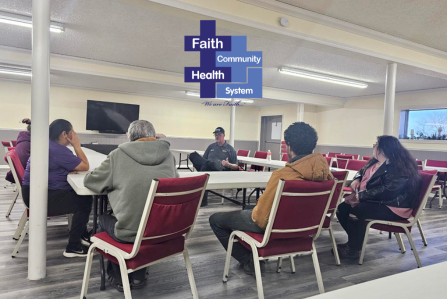Kelley Hudson, Director of the Faith Community Health System EMS, has worked in emergency medical services for the past 39 years. His team, which is the only 911 provider in Jack County, handles more than 1,500 calls for assistance every year.
Hudson said he has heard his share of first aid myths and does everything in his power to dispel them by visiting with citizens throughout the county to discuss the importance of knowing and understanding how to provide basic first aid.
He recently met with a group of seniors to discuss the dangers of falls and how to make sure their home surroundings are free of fall hazards. Hudson also spoke with Head Start children and their parents at the Live Oak Baptist Church in Jacksboro. The children were invited to explore the ambulance and Melanie Belcher, one of Faith’s Community Liaisons, handed out first aid kits and thermometers to all families in attendance.
Dispelling First Aid Myths
Myths, Hudson said, can cause serious harm in emergencies. Doing the wrong thing, in fact, can do more harm than good.
However, when people understand basic first aid care and have supplies on hand if someone gets injured, helpful treatment can begin right away. On-the-spot first aid comes in handy whether the injury can be managed at home or needs medical assistance in the clinic or emergency room.
Even if the injury is serious enough to require a call to 911, first aid can minimize further damage.
“Being able to perform first aid can keep a situation from getting worse while people are waiting for the ambulance to arrive,” said Hudson, who noted that while his team always responds to calls as fast as possible, Jack County covers a large area. Being able to perform simple first aid when needed can begin the process of care when help is on the way.
Additionally, knowing when to call for emergency medical help and when an injury can be treated without seeing a medical professional is important, as well, he said. For example, a headache can most often be treated at home. A headache accompanied by blurry vision, or a change in mental status, should be evaluated by a doctor as soon as possible. Likewise, sprains can be treated with ice (never heat!) but if you are concerned about a broken bone, a trip to the emergency department is in order.
Burns
Don’t put butter on a burn. Butter can actually exacerbate the damage caused to the skin by a burn.
Don’t apply ice to a burn!
Administer First Aid for a Burn
“Proper first aid for a burn is to run the body part under cool water for 10 to 15 minutes,” Hudson said. “It will cool minor burns and prevent further skin damage.”
In some cases, the burn may require medical care. If blisters form or the burn covers a large area of skin, don’t hesitate to go to the clinic or emergency room if it’s after hours. And, of course, call 911 for emergency medical assistance if you are concerned that the burn is life threatening.
This is a better safe than sorry situation. Make the call if you are concerned about the severity of the burn.
Nosebleeds
Don’t have the person lay down or lean back – blood can collect in the mouth or throat.
Don’t pinch the bridge of the nose – pinching the bone will not stop blood flow.
Administer First Aid for a Nosebleed
Sit down and lean forward. Pinch the soft part of the nose, the area just above the nostrils, and apply pressure for 10 to 15 minutes.
If the nosebleed slows considerably, repeat nosebleed first aid. If the bleeding does not seem to be slowing and stopping or, in fact, gets worse, go to the clinic, Emergency Department or call 911.
Heart Attack
If you or someone else may be having a heart attack, basic first aid knowledge can be your best friend in the moment.
Administer First Aid for a Heart Attack
Don’t delay in calling 911. This is a true medical emergency.
Don’t lie down. Lying down can force a bit more blood into the heart causing undue stress. Sitting up causes the least amount of stress on the heart.
Don’t give the person anything to eat or drink (other than prescribed medication).
Unfortunately, there is not much that can be done for someone having a heart attack without the proper medical equipment. However, doing the wrong thing can exacerbate the problem! While you wait for the ambulance, remain calm and take the actions you can take.
DO stop activity.
DO remain (or keep the patient) in a half-seated position until help arrives
DO take (or give) a 325 mg. aspirin (if there is no allergy)
Be ‘In the Know’ about First Aid
While having a well-stocked first aid kit can come in handy, knowing what to do in case of an emergency can bring peace of mind. Learning how to perform CPR and administer basic first aid is good advice for everyone, Hudson said.
And, as noted, knowing the difference between first aid myths and helpful care can mean the difference between helping or hurting the injured person and, in serious situations, it might mean the difference between life and death.
If you are interested in having Hudson speak to your community group, please contact Kelley Hudson, EMT-P, Faith Community Health System, at khudson@fchtexas.com or call 940-567-6633 ext. 336

